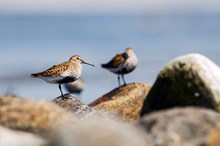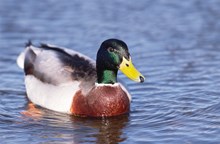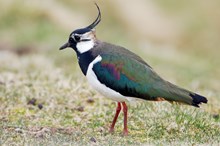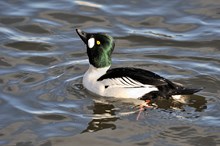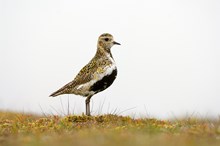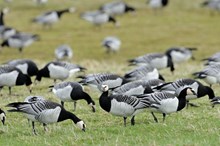14 December, 2020
Wintering waterbirds on the increase
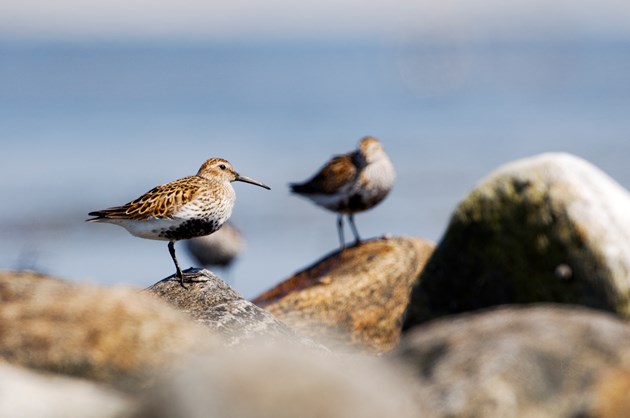
Numbers of wintering waterbirds in Scotland have increased overall but some species, particularly waders, are being affected by our changing climate.
NatureScot’s latest Biodiversity Indicator monitors the populations of 41 species including wildfowl, waders, cormorant, grebes and coot using data from the Wetland Bird Survey.
The research shows that overall numbers have increased by 25% since 1975, but there is considerable variation between groups and individual species. Most waterbirds can be highly mobile and research has shown that some are shifting their distributions in response to environmental changes.
Numbers of waders – including species such as dunlin, knot, golden plover and lapwing - have declined by 10%, after peaking around 1997/98.
Part of the reason for this is climate related - Scotland is in an important position within the East Atlantic Flyway, the migration route used by these waders, and climate change has resulted in some species shifting wintering sites.
Knot and dunlin, for example, are highly mobile, with milder winters allowing birds to remain on continental wintering sites rather than coming to Scotland.
Wildfowl numbers have remained relatively stable, but while species such as swans and red-breasted merganser have increased, goosander, goldeneye and scaup have declined.
Mallard numbers in Scotland have also declined by 40%, matching the UK national trend. The reasons are unclear, but some mallard migrate from the continent and may be choosing to remain there during milder winters. Further research is required to understand the reasons for the decrease.
Meanwhile the majority of goose populations have increased. Barnacle geese have seen some of the largest increases, while in contrast, Greenland white-fronted geese have declined since the late 1990s.
Factors on the breeding grounds, including high late-spring snowfall and competition with Canada geese that are spreading northwards into Greenland, appear to be having an impact on white-fronted geese.
Simon Foster, NatureScot Trends and Indicators Analysis Officer, said: “Scotland’s coasts and waters are hugely significant for wildfowl and wader species, with more than 50 sites of international importance. Many are long-distance migrants, breeding in the high Arctic and wintering in Scotland.
“Our latest indicator helps put a spotlight on our internationally important waterbirds. By supporting research and working with others across the flyway we can start to understand the complex and beguiling reasons for the trends we are seeing.
“A greater understanding of these trends would not be possible without the help of the many fantastic volunteers who brave the winter weather to count waterbirds around our estuaries. New counters are always welcome so if you’d like to lend a hand to help our waterbirds you can get involved too.”
Ben Darvill, BTO Scotland development and engagement manager, said: "Volunteer birdwatchers work together throughout Scotland, heading out once a month to monitor a diverse range of wetland and coastal sites.
“It's their sightings which allow these assessments of population change. There are Wetland Bird Survey sites for all abilities, from village duckponds to complex estuaries. The information is all valuable, and volunteers can make a meaningful contribution while enjoying some fresh air. Contact BTO Scotland for further information."
ENDS
Contact information
- Name
- NatureScot Media
- Telephone
- 0131 316 2655
- media@nature.scot
Notes to editors
Read the full indicator here: https://www.nature.scot/scotlands-indicators-wintering-waterbird-indicator
Each month throughout the winter, volunteers count waterbirds around Scotland’s estuaries, rocky shorelines and inland waterways. These counts are mostly undertaken through the Wetland Bird Survey, with additional targeted counts for geese and swans, and periodic surveys of rocky shore waterbirds. The results are used to provide population estimates, determine trends in numbers and distribution, and identify important sites for waterbirds
The Wetland Bird Survey operates throughout Scotland. Although most major waterbodies and estuaries are covered by volunteers, there is always a need for new counters. Counts from areas not well monitored (such as North West Scotland and smaller inland waterbodies) are welcome as well. Contact BTO (https://www.bto.org/our-science/projects/wetland-bird-survey/taking-part).
BTO is the UK's leading bird research charity. A growing membership and up to 60,000 volunteer birdwatchers contribute to BTO's surveys, collecting information that underpins conservation action in the UK. BTO maintains a staff of 100 at its offices in Thetford, Stirling, Bangor (Wales) and Belfast (Northern Ireland), who analyse and publicise the results of surveys and projects. BTO's work is funded by BTO supporters, government, trusts, industry and conservation organisations. www.bto.org
NatureScot is Scotland's nature agency. We work to enhance our natural environment in Scotland and inspire everyone to care more about it. Our priority is a nature-rich future for Scotland and an effective response to the climate emergency. For more information, visit our website at www.nature.scot or follow us on X at https://x.com/NatureScot
’S e NatureScot buidheann nàdair na h-Alba. Bidh sinn a’ neartachadh àrainneachd na h-Alba agus a’ brosnachadh dhaoine gu barrachd suim a chur ann an nàdar. Tha e mar phrìomhachas againn gum bi nàdar na h-Alba beairteach agus gun dèilig sinn gu h-èifeachdach le èiginn na gnàth-shìde. Tha an tuilleadh fiosrachaidh aig www.nature.scot no air X aig https://x.com/NatureScot

